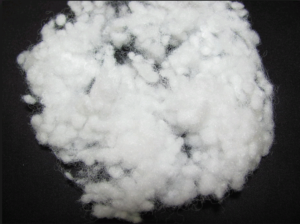Discovered at the beginning of the 20th century, polyester filled the market for goods for various purposes. In the textile industry, this material makes up more than half of the fabrics.
The finest fibers are intertwined to create threads of various shapes: round, triangular, square. A variety of textured fabrics with the best properties, analogues of natural ones, are obtained.
100% Polyester
 Often in the store the question is asked, what kind of insulation is this? This is a non-woven material made from polyester fibers. Each manufacturer uses its own technology and creates a unique fabric that differs from others in its ability to store heat, tolerate machine washing and wear resistance. It is rare to find true polyester in its pure form. You should not trust the labels and tags on the clothes and products you purchase. It is mainly combined with other fibers:
Often in the store the question is asked, what kind of insulation is this? This is a non-woven material made from polyester fibers. Each manufacturer uses its own technology and creates a unique fabric that differs from others in its ability to store heat, tolerate machine washing and wear resistance. It is rare to find true polyester in its pure form. You should not trust the labels and tags on the clothes and products you purchase. It is mainly combined with other fibers:
- Cotton - 65%. The resulting fabric becomes durable when worn, is not exposed to solar radiation, and does not wrinkle;
- Viscose - 30%. The most popular option.The material does not deform and does not fade;
- Polyamide. Becomes resistant to temperature, does not allow moisture to pass through, and gains additional elasticity;
- Spandex. Interacting with polyester, it acquires an airtight and stable structure;
- Yarn. There is a higher quality of finished products. They do not stretch, do not wrinkle and last a long time.
The use of synthetic fiber is presented in a wide range of products: tracksuits, curtains, hosiery, jackets. It is absolutely safe, does not absorb moisture and is heat resistant.
On the ready-made clothing market, 100% polyester insulation is found:
- holofiber;
- padding polyester;
- fleece;
- Polartek;
- holophane;
- thermofinn;
- Junsen;
- isosoft.
Any material consists entirely of polyester. In special clothing, insulation materials designed for special conditions and low temperatures are used:
- Americans developed Thinsulate for astronauts;
- Thermium has a base made of aluminum film with fibers woven into it;
- Jopfil is designed for workwear.
Synthetic insulating material, regardless of the production method, does not cause allergies, and moths will not spoil it.
Polyester fiber undergoes a complex purification process. The quality and safety of the finished product depends on compliance with the technology. The seller may set a high price. In order not to be deceived, the insulation material and fabric must be crumpled and smelled. Low quality will give off a sour smell and feel of fiberglass in the hand.
The first insulation is synthetic winterizer
 Raw materials made from 100% polyester are divided into:
Raw materials made from 100% polyester are divided into:
- old;
- new.
The first category includes a material consisting of two or more layers of fibers directed in the same plane.It is recommended to wear it in the off-season, in cold weather no more than 5 degrees below zero. The bond between polyester threads is weak. The insulation quickly wears out, begins to roll off and break through the upper material.
In the new padding polyester, 100% polyester insulation has an air layer and thermally bonded fibers. It is lighter in weight, retains heat well, and lasts a long time.
Improved polyester has many advantages over its predecessor.
After washing, up to 50% of the thickness is still lost.
Advantages of padding polyester
- spring durable fiber structure;
- light weight;
- heat retention at external temperatures down to -25 °C;
- does not allow moisture or air to pass through;
- washable at 30°C, does not require additional heat treatment;
- dries quickly;
- not deformed.
Such insulation will preserve the appearance of clothing, its primary color and structure for a long time. This is especially important in winter. In windy and frosty weather it will reliably protect against hypothermia and keep you warm.
Disadvantage of padding polyester
- cannot be machine washed;
- it is contraindicated to twist;
- temperature up to 40 degrees;
- dry vertically.
Manufacturers use padding polyester when sewing inexpensive clothes.
The second is holofiber
 Non-woven polyester fabric was developed by Russian specialists. The material, which is hollow inside, holds heat well and does not wrinkle. Between the two outer layers, the fibers are arranged perpendicular to the surface or twisted into balls.
Non-woven polyester fabric was developed by Russian specialists. The material, which is hollow inside, holds heat well and does not wrinkle. Between the two outer layers, the fibers are arranged perpendicular to the surface or twisted into balls.
A distinctive feature is its ability to create optimal conditions for humans. Excess moisture comes out through the loose surface. The heat is retained. The body does not freeze and does not sweat.
Holofiber is allowed for sewing children's clothes. It is used to make clothing for winter sports.It is completely safe even for people prone to allergies. The characteristics are similar to natural bird down. It withstands machine washing well in a gentle cycle. Things made of 100% polyester last a long time and retain their appearance.
It turns out that holofiber and comforter are about the same thing. Polyester fiber, after special processing, is crumpled into small balls approximately 5 mm in diameter. This type of filler is called holofiber in English and lomforel in French. This material is superior in quality to synthetic winterizer.
Third - isosoft, hollofan, Thinsulate and others
 Foreign manufacturers call polyester insulation differently. The material they produce differs mainly in the shape of the fibers inside the fabric.
Foreign manufacturers call polyester insulation differently. The material they produce differs mainly in the shape of the fibers inside the fabric.
Hollophan got its name from a combination of words in English: “hollow” and the name of the company “Fanema”. The void is filled with polyester fibers twisted into springs.
Belgian isosoft contains hollow balls inside. Produced by Libeltex.
Both materials are similar in quality to holofiber. Significantly warmer and stronger than synthetic padding.
The rest can be supplemented with hollow and bicomponent fiber. Have different structures and bonding technologies with acrylic glue and other substances. Their cost is higher. They are found less often in the store.
Polyester has become widespread. The world leader in its production is Fellex, which operates at the Ziran plant in China.
Thinsulate - artificial down. There is a legend that it was originally intended for use in space. In any case, Thinsulate is much better than synthetic padding. It retains its shape well after washing, keeps you warm in severe frosts (down to -30°), and the products are very light. Does not cause allergies.Clothes made from this material are used by athletes, climbers, and oil workers.
The fiber has the shape of a spiral, inside which air is collected, which retains heat.
More information about fellex 100% material
 The filler comes in a variety of shapes and is made in the form of balls or solid sheets.
The filler comes in a variety of shapes and is made in the form of balls or solid sheets.
A distinctive feature of the material is that the insulation layers are fused using high temperatures. Fellex 100% polyester (120, 220, 250, 300 g/m²) has a high level of wear resistance and does not require special care.
How warm is it in products with fellex filling?
The peculiarity of outerwear is its lightness; the process of making insulation, which includes 100% polyester 250 g m², differs from the production of padding polyester. The material does not contain an adhesive base that holds the fabric together, so the fibers do not roll off during wear, quickly taking their original shape.
This is a light and thin filler, it warms well in severe frosts, trapping heat inside the lining.
Thermal insulation material from the fellex company is an excellent replacement for natural filler, but its cost is much lower. Due to its advantages, this material has become widespread among manufacturers of winter jackets for both adults and children.
Its lightness ensures comfort when wearing clothes, and ease of care and long service life do not burden housewives with additional problems.
Insulation for winter clothes
Holofiber SOFT. Lightweight, elastic and heat-resistant material. Even in frosty weather and temperatures of -25 °C it will retain heat and protect against hypothermia.
Thinsulate. Its structure resembles natural fluff. New technologies allow it not to lose its shape, repel moisture and participate in heat exchange.Provides excellent warmth at -30°C.
Belarusian Fibertek. Hypoallergenic, lightweight and durable. Temperature fluctuations up to -40 °C. An ideal solution for long walks in the fresh air.
American brand PrimaLoft. The basis for the creation was the imitation of the characteristics of down, but with an improved structure and use of fiber. This type is designed specifically for outdoor activities and sports, provided that the temperature does not reach -20 °C.
Belgian Isosoft. The presence of a double spunbond fabric gives additional density and lightness to the filler. The possibilities are limited by cold down to -20 °C.
Advantages of clothing insulation:
- withstands temperatures down to -25 degrees;
- easy to wash and straighten after washing;
- does not lose shape;
- There are no allergies to polyester. It is completely safe for the skin, the only limitation is that it is better not to wear this material on a naked body and for pregnant women;
- clothes with polyester insulation can be worn not only in winter, but also in spring and autumn. This quality significantly distinguishes polyester from other insulation materials, because versatility is always good;
- the clothes are very light, but they warm several times better than jackets made from natural fillers;
- durable;
- It does not require special care;
- does not cause excessive sweating. Thermal underwear is made from polyester, which means it retains heat well;
- wear resistance, the product can last for a fairly long period without losing important properties;
- thanks to the manufacturing method, it does not electrify and quickly restores its shape;
- thermal insulation characteristics are identical to those of natural materials;
- The cost of jackets with such filling is much lower than their analogues.
Flaws
- It is not recommended to use chemical bleaches;
- When buying products that are too cheap, it is worth remembering that polyester fiber can cause an allergic reaction;
- Slight rigidity of the material;
- Electrification. Easily removed with an antistatic agent.
Polyester: proper care and washing
 Even though polyester material is so versatile and practical, it does have a number of disadvantages that you should consider. Not suitable for long-term wear, may cause allergies, and has poor heat conductivity. Polyester in clothes and the fabric for sewing them also needs special care:
Even though polyester material is so versatile and practical, it does have a number of disadvantages that you should consider. Not suitable for long-term wear, may cause allergies, and has poor heat conductivity. Polyester in clothes and the fabric for sewing them also needs special care:
- hand wash no more than 40 °C;
- machine On delicate mode. The temperature should not exceed 40 °C. Choose a spin speed of about 800 rpm to avoid damaging the item. Use a softening conditioner;
- clothes that are too dirty will require pre-treatment with a stain remover and soaking;
- Dry only in a well-ventilated area. Avoid exposing the fabric to direct sunlight;
- ironing exclusively in the “Silk” mode.
It is strictly forbidden to treat polyester material at high temperatures or boil it. Otherwise, the fabric structure may be damaged and the product may be deformed.
Manufacturers offer a wide selection not only in models and sizes, but also in technical characteristics. This makes it possible to choose outerwear in accordance with the season and weather conditions; for each temperature there is a certain amount of filler in clothing. For example, up to 0° a density of 40–70 g/m2 is suitable. m. Jacket with 100–150 g/sq. m. will warm up to -10°, and frost up to -40° will withstand an indicator of 200–300 g/sq. m.
Synthetic fillers have a number of advantages over natural analogues. They are lighter, easier to maintain and durable.The ability to retain the amount of heat necessary to maintain comfort is an important criterion for choosing a product with polyester insulation.
It is also worth considering that clothes with synthetic fillers can have different variations of styles. This makes a winter outfit more elegant and sophisticated.



 1
1






All the same, whatever one may say, polyester is the best among insulation materials.
But you sweat like a dog in it and it sticks terribly to the skin, very uncomfortable...
According to your words, it turns out that polyester is its own insulation material, and is also a raw material for other types of insulation materials. What a nonsense.